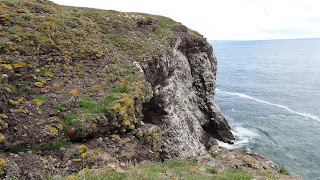 |
| A map with all the places to look for birds. |
We drove south out of Stonehaven on the coast highway, until we saw the signpost to Crawton, where the road became one lane with passing places. Fortunately, it was fairly straight, so we drove as fast as we could until we came over a crest to find the car park. The signs are quite clear, which made it easy.
 |
| Watch for nesting birds and leave them alone. |
 |
| The cliffs are 70 meters high; the views are spectacular! |
The hike from the car park was made easier by using my hiking poles. It was very up and down, crossing a couple of small bridges over streams, and muddy. Well, it is Scotland and it does rain some every day!
We met a couple who were coming back from watching and photographing the birds. He warned us about the smell. I guess you can't have that many birds in one place without a bit of smelly poop.
 |
| Razorbills, notice the white lines on their bills. It took us a while to tell them from the Guillemots. |
The birds were everywhere; on the cliffs, in the water, flying in the air. It was a bit overwhelming. Where do you look first? Bill had his camera to look through, while I use the binoculars.
 |
| Common Guillemots |
 |
| Herring Gull |
 |
| A Guillemot cliff side neighborhood. |
The cliffs aren't the only thing covered with birds, the oceans was teeming with them. There were what appeared to be schools of fish, with the birds all over them. Some of the birds just dunked down to catch a fish, or tried to steal them, while others would dive and swim underwater, emerging victorious with a fish in their mouth.
 |
| The cliffs are extremely straight up and down, but covered in nesting birds. |
It was a bit dizzying looking over the cliffs and watching the birds fly and swoop about. To give you an idea of the noise level, at times the bird calls would drown out the waves crashing on the cliffs. There are dolphins and whales in these waters as well, so I was on the lookout for them too. We did spot a couple of Harbor Seals when they popped their heads out of the water.
 |
| A Puffin pair sitting on a tiny outcropping in front of their nest. If they have eggs or babies, they are inside a hole in the cliff behind them. |
 |
| Just behind his tail is a small slit in the stone which goes back to a nest. |
Yes, after many years of failed attempts, we finally found Puffins. They are much smaller than I expected, but stand out because of their magnificent coloring. When they fly, the use those lovely orange feet as rudders! Quite a sight to see!
 |
| Three adult Kittiwakes with a baby in the nest. |
One things we learned on this hike, Kittiwake numbers are dropping drastically. Conservationist have put the decline down to the North Sea's food chain being affected by climate change. Some nests have had the babies die of starvation because the main food source, a small eel, is not available in adequate number since the water is warmer.












No comments:
Post a Comment